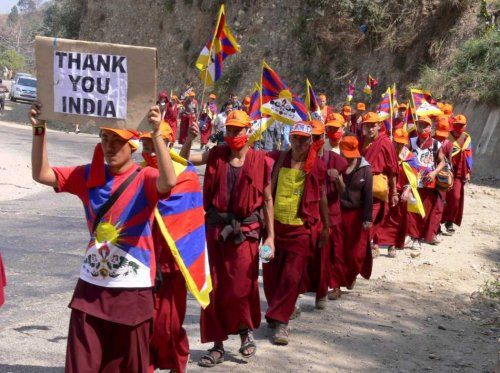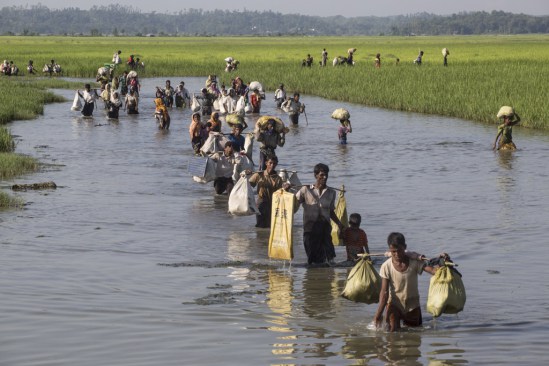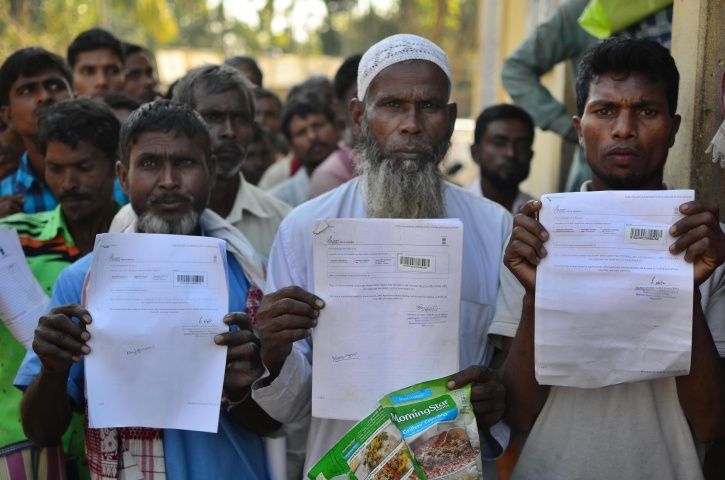
- Sreekar Aechuri 26 March 2019
As per UNHCR, India roughly hosts 2,07,000 refugees in various parts of the country.[i] It hosts diverse groups of refugees from Tibet, Sri Lanka, Myanmar, Somalia, Afghanistan etc. Despite hosting a large population of refugees from diverse backgrounds, India does not have a legal framework for the refugees and is not even a signatory to the 1951 United Nations Refugee Convention or 1967 Protocol to the 1951 Convention. Hence, refugees are treated as aliens under law unless special provisions for particular groups were made.[ii] No distinction is drawn between foreigners and refugees under Indian laws and hence, refugees are also governed under the Foreigner’s Act, 1946.[iii] Since, there is no specific legal framework for governing refugees, it is the decision of the Executive whether to treat a person or a group of people as refugees leaving it prone to decisions based on arbitrariness, political alignments and interests.[iv]
Unless provided by special provisions, the refugees are rendered assistance by UNHCR through its mandate with the permission of the Central Government.[v] UNHCR operates through regional collaborations with various local NGOs like Socio-Legal Information Centre in New Delhi, Gandhi National Memorial Society in Pune, Confederation of Voluntary Agencies in Hyderabad, Development and Justice Initiative in Jammu, Mewat and Jaipur etc.[vi]
Some fundamental rights are guaranteed to all persons including refugees enshrined in Part III of the Indian Constitution viz., right to equality,[vii] right to life and personal liberty, education, medical assistance and privacy,[viii] freedom of religion,[ix] right to protection from arbitrary arrests[x] and right to approach Supreme Court for enforcement of these Fundamental Rights.[xi]
The
Supreme Court along with quite a few High Courts have used the principles of equity,
good conscience and justice to cases involving refugees, their status,
deportation etc.[xii]
The Madras High Court in the case of P.
Neduram v. Union of India,[xiii]
has acknowledged the competence and impartiality of UNHCR in Refugee Status Determination (RSD) and Voluntary Repatriation and recognized
the organization’s important role in the protection of refugees. The Bombay
High Court in the case of Syed Ata
Mohammadi v. Union of India,[xiv]
held that the Iranian refugee will not be deported as he was recognized by the
UNHCR. In a similar trend of cases, the Supreme Court has stayed the
deportation of refugees from various countries[xv] but when the turn of rohingya
refugees has come, the courts were not in consonance with the earlier decisions.
Differential Treatment by the Government towards Refugees
India has accorded differential treatment to refugees belonging to different socio-cultural groups. Tamil refugees from Sri Lanka were treated with international principles of non-refoulement and official refugee status determination.[xvi] National Human Rights Commission has commented that the Chakma refugees were not even provided with basic facilities for sustenance.[xvii] Rohingya refugees are not provided with basic facilities and also deported to Myanmar.[xviii] Tibetan refugees received far better treatment in comparison with other refugee groups.[xix]
I. Tamil Refugees from Sri Lanka

Tamil refugees from Sri Lanka have moved to India during the 1980-90 decade due to war and unrest in the Eelam area with the Liberal Tigers of Tamil Eelam (LTTE).[xx] Roughly 1 lakh people are taking refuge in India currently of which roughly 63,000 people are staying in the 109 refugee camps in Tamil Nadu.[xxi] It has been nearly 35 years, but there is only a slight improvement in the living conditions of these refugees.[xxii] The refugees staying in the camps have been receiving relief measures from the Centre and the State government in the form of money, accommodation, education, food grains.[xxiii] Each refugee family is provided with 20kg ration rice per month and the children are given education in government schools till the class of 12th.[xxiv] Head of each family shall receive Rs. 1000; every other adult Rs. 750 and every child Rs. 400 per month.[xxv]
The Madras High Court has expressed its unwillingness to forced repatriation of Sri Lankan refugees and asked the UNHCR to help in the voluntary repatriation procedure.[xxvi] Though there is only a slight improvement in their conditions, it is important to acknowledge the government’s acceptance of Sri Lankan Tamils as refugees and providing them with basic necessities.
II. Tibetan Refugees from China

After the Dalai Lama fled to India in 1959, roughly 100,000 Tibetans have sought refuge in 39 settlements of North-Eastern regions of India.[xxvii] They are provided with educational facilities and reservations in medical and engineering colleges.[xxviii] A few of these refugees are eligible for voter IDs and citizenship rights[xxix] due to a policy change by the Ministry of External Affairs, Tibetan refugees born in India in the period of 1950-87 would be entitled to Indian passports and their nationality cannot be questioned under the Citizenship Act, 1955. The government finally instituted the Tibetan Rehabilitation Policy in 2014 mandating the State governments to extend the benefits of social welfare schemes to Tibetan refugees without distinguishing them with Indian citizens but excluding government jobs, right to travel freely within and outside India.[xxx] The Centre has also sanctioned Rs. 40 crores for a period of 5 years to the Central Tibetan Relief Committee (CTRC) for social and economic welfare of the Tibetan refugees in India.[xxxi]
III. Rohingya Refugees from Myanmar

Rohingya refugees are ethnic Muslims from the Rakhine State of Myanmar. United Nations described them as the most persecuted minorities in the world.[xxxii] It is roughly estimated that India hosts 40,000 rohingya refugees predominantly in Delhi, Jammu & Kashmir, West Bengal, Hyderabad and North-East India.[xxxiii] Of these 40,000 rohingyas, only 18,000 are registered and have UNHCR refugee cards[xxxiv] because UNHCR is allowed to operate only in New Delhi and the rohingyas that are residing in other parts of the country do not have the economic means to travel and stay in New Delhi while they are being assessed which is a process that generally takes six months to an year to be concluded.[xxxv] As India is not a party to the 1951 Convention, it treats all the 40,000 rohingyas in the country as illegal migrants instead of refugees.[xxxvi]
The rohingyas in Jammu and Kashmir work in fruits and vegetables markets, local small-scale industries and have their clusters around the outskirts of the Jammu city where the landowners charge them up to Rs. 1000 per jhuggi with electrical supply.[xxxvii] Water and Electricity amenities are not provided to the refugees and hence the landowners in their name provide these basic facilities at high rates exploiting the impoverished refugees.[xxxviii] Without directly referring to them, the Chamber of Commerce and Industry of Jammu has termed their presence to be a ‘sinister campaign to change the demographics of the Jammu region.’[xxxix] There are roughly 3,200 rohingyas in 12 major camps in Hyderabad and a majority of them are employed in meat shops and factories.[xl] The rohingya refugees’ condition are comparatively better in Jaipur and Delhi as most of them have the UNHCR refugee identity cards though not recognized by the government have a positive impact on the people in their treatment towards rohingyas.[xli]
On August 8, 2018, the Union Home Ministry through a letter sent to all the states has communicated that rohingyas pose a threat to national security and hence the intelligence agencies of each state shall take immediate steps to identify them and initiate the deportation process and yet no evidence has been presented by the government to suggest that the rohingya refugees are in fact terrorists and pose a threat to the national security.[xlii] After the Supreme Court judgment in October, 2018, the Indian government has deported seven rohingya refugees who had been held in the Silchar prison to Myanmar on charge of illegal entry into India.[xliii]
The ripple effect of such deportation has been the fleeing of dozens of rohingyas from India by crossing the border into Bangladesh.[xliv] As per the Bangladesh border officials, at least 57 rohingya refugees from India have been detained in the past few months and sent to the Cox’s Bazar refugee camp.[xlv] It can be safely concluded by the actions of the Indian government that in finding the balance between security and safety, the government has lost its humanity.
IV. The Citizenship (Amendment) Bill, 2016

This Bill intends to make illegal migrants (includes refugees) who are Hindus, Sikhs, Parsis, Jains, Christians and Buddhists from Pakistan, Bangladesh and Afghanistan entitled to Indian citizenship.[xlvi] This bill is passed by Lok Sabha in January 2019.[xlvii] The key issue with the bill is its provision on citizenship to illegal migrants on the basis of religion.[xlviii]
If passed, this bill shall provide the option of citizenship
to roughly 8500 Afghan refugees, more than 400 Pakistani Hindu refugee
settlements, Buddhist Chakmas and Hindu Hajongs from Bangladesh.[xlix]
This bill shall not apply to the Muslim refugees of these same groups. There
are criticisms from many scholars on the distinction being made to serve the
political interests of the ruling Bharatiya Janatha Party.[l] There
is a strong case for this provision to be violative of Article 14 of the Indian
Constitution which provides the exception of differentiation only if it serves
a reasonable purpose and such a purpose is generally explained in the Statement
of Objects and Reasons of the Bill and this bill was silent on this issue.
The Way Ahead
A person who has left his/her home country leaving everything that he/she has gained/earned – money, name, goodwill, family, friends, culture and has come to a foreign land (host country) in the hope that he/she would be provided an opportunity to live should not be made to sustain in the conditions which does not enable him/her to live.
Countries create a uniform structure for protecting refugees either by legislations based on International law principles or by becoming signatories to international refugee conventions. India hosts refugees but is lacking consistency in its procedure leading to differential treatment and arbitrary procedures for refugees by placing their rights in the vacuum.
The
solution to treat these issues, protect the refugees’ rights and enabling them
to live a life of dignity could be worked on through enacting a uniform
domestic legislation by incorporating International Humanitarian Law principles,
conventions, foreign legislations which will not only help India in maintaining
its territorial integrity but also in establishing benchmarks of its respect
for basic rights/fundamental rights/human rights.
[i] Population Statistics Database, UNHCR, at: http://popstats.unhcr.org/en/overview#_ga=2.178586860.99097897.1550216676-238897977.1542118270
[ii] T. Ananthachari, Refugees in India: Legal Framework, Law Enforcement and Security, Year Book of International Humanitarian and Refugee Law, Indian Society of International Law, 2001.
[iii] Refugee Law: The Indian Perspective, LawTeacher, November 2013, at: https://www.lawteacher.net/free-law-essays/international-law/refugee-law-the-indian-perspective-law-essay.php?vref=1
[iv] Vivek Kumar, A study of refugee’s in India: The Legal Perspective, International Journal of Law, Vol 3, Issue 7, September, 2017.
[v] supra note 2.
[vi] Assistance – What Do We In India, UNHCR, at: https://www.unhcr.org.in/index.php?option=com_content&view=article&id=8&Itemid=130
[vii] Article 14, Indian Constitution, January 26, 1950.
[viii] Ibid, Article 21.
[ix] Id, Article 25.
[x] Id, Article 22.
[xi] Id, Article 32.
[xii] supra note 2.
[xiii] P. Neduram v. Union of India, 1993 (2) ALT 291.
[xiv] Syed Ata Mohammadi v. Union of India, WP (crim) No. 7504/1994 at Bom HC.
[xv] Maiwand’s Trust of Afghan Human Freedom v. State of Punjab, WP (crim) No.s 125 and 126/1986 at SC; N. D. Pancholi v. State of Punjab & Ors, WP (civil) No. 1294/1987 at SC, State of Arunachal Pradesh v. Khudiram Chakma, 1994 Supp. (1) SCC 615.
[xvi] Harsh Bajpai & Ananya Pratap Singh, The Misery of Refugees: Issues, Governance, Challenges and Solutions, Law Mantra, Vol 3, Issue 1, September, 2015.
[xvii] supra note 3.
[xviii] Sobhapati Samom & Sadiq Naqvi,7 Rohingya refugees deported to Myanmar after Supreme Court refuses to intervene, Hindustan Times, October 4, 2018, at: https://www.hindustantimes.com/india-news/7-rohingyas-deported-from-assam-after-supreme-court-refuses-to-intervene/story-rf4FwSDi5TAxaCpN6GsCqN.html
[xix] supra note 16.
[xx] Akshaya Nath, The ignored plight of Sri Lankan refugees in Tamil Nadu, India Today, June 9, 2016, at: https://www.indiatoday.in/india/story/sri-lankan-refugees-tamil-nadu-plight-camps-war-13168-2016-06-09
[xxi] Ibid.
[xxii] N. Sathiya Moorthy, Why Lankan refugees are reluctant to go back home, The Times of India, August 28, 2019 at: https://timesofindia.indiatimes.com/city/chennai/why-lankan-refugees-are-reluctant-to-go-back-home/articleshow/65591130.cms
[xxiii] supra note 20.
[xxiv] Id.
[xxv] Id.
[xxvi] Gurunathan & Ors v. Government of India, WP No.s 6708 and 7916/1992; P. Neduram v. Union of India, 1993 (2) ALT 291.
[xxvii] Decades after fleeing Tiber, Refugees still have limits on rights in India, VOA News, June 21, 2017, at: https://www.voanews.com/a/decades-after-fleeing-tibet-refugees-still-have-limits-rights-india/3911014.html
[xxviii] Ibid.
[xxix] Gaurav Bisht, Tibetan refugees to be given benefits of welfare schemes, Hindustan Times, June 2, 2014, at: https://www.hindustantimes.com/chandigarh/tibetan-refugees-to-be-given-benefits-of-welfare-schemes/story-2AqbgUwlFM2S8VsGfEzShL.html
[xxx] Rajeswari Pillai, India and international refugees: Time to rethink?, Observer Research Foundation, September 28, 2017, at: https://www.orfonline.org/expert-speak/india-and-international-refugees-time-for-rethink/
[xxxi] Ibid.
[xxxii] Rohingya Refugee Crisis, UNHCR, at: https://www.unrefugees.org/emergencies/rohingya/
[xxxiii] Maya Mirachandani, SC refuses to stay deportation of 7 Rohingya refugees; UNHCR says ‘Not Safe’ to return to Myanmar, The WIRE, October 4, 2018, at: https://thewire.in/rights/with-india-set-to-deport-7-rohingya-refugees-unhcr-says-not-safe-to-return-to-myanmar
[xxxiv] Dozens of Rohingyas flee India for Bangladesh: Officials, The Straits Times, January 8, 2019, at: https://www.straitstimes.com/asia/south-asia/dozens-of-rohingya-flee-india-for-bangladesh-officials
[xxxv] Kaushik Deka, Is there more to India unwelcoming Rohingya Muslims that meets the eye?, India Today, October 8, 2017, at:https://www.indiatoday.in/magazine/special-report/story/20171016-rohingya-muslims-why-india-wants-them-out-1058101-2017-10-08
[xxxvi] Shaikh Azizur Rahman, Rohingya refugees flee India amid fears of mass deportation, The Telegraph, November 27, 2018, at: https://www.telegraph.co.uk/news/2018/11/27/rohingya-refugees-flee-india-amid-panic-data-collection-drive/
[xxxvii] The Most unwanted: A gripping account of rohingya refugees living in India, The Indian Express, June 26, 2018, at:https://indianexpress.com/article/india/the-most-unwanted-a-gripping-account-of-rohingya-refugees-living-in-india-4464103/
[xxxviii] Ibid.
[xxxix] Id.
[xl] Id.
[xli] Pratim Ranjan Bose, Rohingya refugees: India looking at a long-term solution, The Hindu Business Line, February 23, 2018, at: https://www.thehindubusinessline.com/economy/policy/rohingya-refugees-india-looking-at-a-long-term-solution/article22838513.ece
[xlii] supra note 35.
[xliii] Sobhapati Samom & Sadiq Naqvi,7 Rohingya refugees deported to Myanmar after Supreme Court refuses to intervene, Hindustan Times, October 4, 2018, at: https://www.hindustantimes.com/india-news/7-rohingyas-deported-from-assam-after-supreme-court-refuses-to-intervene/story-rf4FwSDi5TAxaCpN6GsCqN.html
[xliv] supra note 34.
[xlv] Ibid.
[xlvi] § 2, The Citizenship (Amendment) Bill, 2016.
[xlvii] The Citizenship (Amendment) Bill, 2016, Bill Track, PRS Legislative Research, at: https://prsindia.org/billtrack/the-citizenship-amendment-bill-2016-4348
[xlviii] Ibid.
[xlix] Nafees Ahmad, The Status of Refugees in India, Fair Observer, September 12, 2017, at: https://www.fairobserver.com/region/central_south_asia/refugees-rights-india-south-asian-world-news-headlines-97021/
[l] Ibid.
